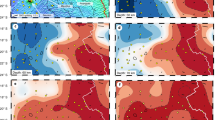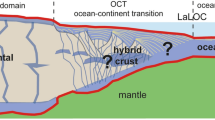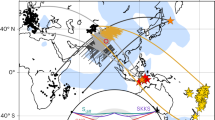Abstract
In the past six million years, Baja California has rifted obliquely apart from North America, opening up the Gulf of California1. Between transform faults, seafloor spreading and rifting is well established in several basins. Other than hotspot-dominated Iceland, the Gulf of California is the only part of the world’s seafloor-spreading system that has been surrounded by enough seismometers to provide horizontal resolution of upper-mantle structure at a scale of 100 kilometres over a distance great enough to include several spreading segments. Such resolution is needed to address the long-standing debate about the relative importance of dynamic and passive upwelling in the shallow mantle beneath spreading centres. Here we use Rayleigh-wave tomography to image the shear velocity in the upper 200 kilometres or so of the mantle. Low shear velocities similar to those beneath the East Pacific Rise oceanic spreading centre underlie the entire length of the Gulf, but there are three concentrated locations of anomalously low velocities spaced about 250 kilometres apart. These anomalies are 40 to 90 kilometres beneath the surface, at which depths petrological studies indicate that extensive melting of passively upwelling mantle should begin2,3. We interpret these seismic velocity anomalies as indicating that partial melting triggers dynamic upwelling driven by either the buoyancy of retained melt or by the reduced density of depleted mantle.
This is a preview of subscription content, access via your institution
Access options
Subscribe to this journal
Receive 51 print issues and online access
$199.00 per year
only $3.90 per issue
Buy this article
- Purchase on Springer Link
- Instant access to full article PDF
Prices may be subject to local taxes which are calculated during checkout



Similar content being viewed by others
References
Stock, J. M. & Hodges, J. M. Pre-Pliocene extension around the Gulf of California and the transfer of Baja California to the Pacific Plate. Tectonics 8, 99–115 (1989)
Langmuir, C. H., Klein, E. M. & Plank, T. in Mantle Flow and Melt Generation at Mid-Ocean Ridges (eds Morgan, P. J., Blackman, D. K., & Sinton, J. M.) 183–280 (Geophysical Monograph Series 71, American Geophysical Union, 1992)
Asimow, P. D., Hirschmann, M. M. & Stolper, E. M. Calculation of peridotite partial melting from thermodynamic models of minerals and melts. IV. Adiabatic decompression and the composition and mean properties of mid-ocean ridge basalts. J. Petrol. 42, 963–998 (2001)
Nishimura, C. & Forsyth, D. W. The anisotropic structure of the upper mantle in the Pacific. Geophys. J. 96, 203–229 (1989)
Hammond, W. C. & Toomey, D. R. Seismic velocity anisotropy and heterogeneity beneath the Mantle Electromagnetic and Tomography experiment (MELT) region of the East Pacific Rise from analysis of P and S body waves. J. Geophys. Res. 108 2176 10.1029/2002JB001789 (2003)
Ritzwoller, M., Shapiro, N. & Zhong, S.-J. Cooling history of the Pacific lithosphere. Earth Planet. Sci. Lett. 226, 69–84 (2004)
Buck, W. R. & Su, W. S. Focused mantle upwelling below mid-ocean ridges due to feedback between viscosity and melting. Geophys. Res. Lett. 16, 641–644 (1989)
Parmentier, E. M. & Morgan, P. J. The spreading rate dependence of three-dimensional oceanic spreading center structure. Nature 348, 325–328 (1990)
Magde, L. S. & Sparks, D. W. Three-dimensional mantle upwelling, melt generation, and melt migration beneath segmented slow spreading ridges. J. Geophys. Res. 106, 20571–20583 (1997)
Choblet, G. & Parmentier, E. M. Mantle upwelling and melting beneath slow spreading centers: effects of variable rheology and melt productivity. Earth Planet. Sci. Lett. 184, 589–604 (2001)
Toomey, D. R. et al. Skew of mantle upwelling beneath the East Pacific Rise governs segmentation. Nature 446, 409–414 (2007)
Clayton, R. W. et al. The NARS-Baja seismic array in the Gulf of California rift zone. MARGINS Newsl. 13, 1–4 (2004)
Zhang, X. et al. Surface wave tomography of the Gulf of California. Geophys. Res. Lett. 34 L15305 10.1029/2007GL030631 (2007)
Batiza, R. Geology, petrology and geochemistry of Isla Tortuga, a recently formed tholeiitic island in the Gulf of California. Geol. Soc. Am. Bull. 89, 1309–1324 (1978)
Martin, A. et al. Recent volcanism in the northern Gulf of California and the Salton trough: why a preponderance of evolved magmas? AGU Fall Meet. abstr. T11A–1841 (2008)
Axen, G. Extensional segmentation of the main gulf escarpment, Mexico and United States. Geology 23, 515–518 (1995)
Harmon, N., Forsyth, D. W. & Weeraratne, D. S. Thickening of young Pacific lithosphere from high resolution Rayleigh wave tomography: a test of the conductive cooling model. Earth Planet. Sci. Lett. 278 96–106 10.1016/j.epsl.2008.11.025 (2008)
Yang, Y. & Forsyth, D. W. Rayleigh wave phase velocities, small-scale convection, and azimuthal anisotropy beneath southern California. J. Geophys. Res. 111 B07306 10.1029/2005JB004180 (2006)
Faul, U. H., FitzGerald, J. D. & Jackson, I. Shear-wave attenuation and dispersion in melt-bearing olivine polycrystals. II. Microstructural interpretation and seismological implications. J. Geophys. Res. 109 10.1029/2003B002407 (2004)
Hammond, W. C. & Humphreys, E. D. Upper mantle seismic wave velocity: effects of realistic partial melt geometries. J. Geophys. Res. 105, 10975–10986 (2000)
Karato, S. & Jung, H. Water, partial melting and the origin of the seismic low velocity and high attenuation zone in the upper mantle. Earth Planet. Sci. Lett. 157, 193–207 (1998)
Stixrude, L. & Lithgow-Bertelloni, C. Mineralogy and elasticity of the oceanic upper mantle: origin of the low-velocity zone. J. Geophys. Res. 110 B03204 10.1029/2004JB002965 (2005)
Yang, Y., Forsyth, D. W. & Weeraratne, D. S. Seismic attenuation near the East Pacific Rise and the origin of the low-velocity zone. Earth Planet. Sci. Lett. 258, 260–268 (2007)
Hammond, W. C. & Humphreys, E. D. Upper mantle seismic wave attenuation: effects of realistic partial melt distribution. J. Geophys. Res. 105, 10987–10999 (2000)
Forsyth, D. W. & Li, A. in Seismic Earth: Array Analysis of Broadband Seismograms (eds Levander, A. & Nolet, G.) 81–97 (Geophysical Monograph Series 157, American Geophysical Union, 2005)
Yang, Y. & Forsyth, D. W. Regional tomographic inversion of the amplitude and phase of Rayleigh waves with 2-D sensitivity kernels. Geophys. J. Int. 166 1148–1160 10.1111/j.1365–246X.2006.02972.x (2006)
Zhou, Y., Dahlen, F. A. & Nolet, G. 3-D sensitivity kernels for surface-wave observables. Geophys. J. Int. 158, 142–168 (2004)
Zhang, X. et al. 3D shear velocity structure beneath the Gulf of California from Rayleigh wave dispersion. Earth Planet. Sci. Lett. 279, 255–262 (2009)
Acknowledgements
This research was supported by the MARGINS programme of the National Science Foundation.
Author information
Authors and Affiliations
Corresponding author
Supplementary information
Supplementary Figures
This file contains Supplementary Figures S1 - S8 with Legends. (PDF 1693 kb)
Rights and permissions
About this article
Cite this article
Wang, Y., Forsyth, D. & Savage, B. Convective upwelling in the mantle beneath the Gulf of California. Nature 462, 499–501 (2009). https://doi.org/10.1038/nature08552
Received:
Accepted:
Issue Date:
DOI: https://doi.org/10.1038/nature08552
This article is cited by
-
Deep electrical imaging of the ultraslow-spreading Mohns Ridge
Nature (2019)
-
The initiation of segmented buoyancy-driven melting during continental breakup
Nature Communications (2016)
-
High heat flow and ocean acidification at a nascent rift in the northern Gulf of California
Nature Communications (2013)
-
Electrical image of passive mantle upwelling beneath the northern East Pacific Rise
Nature (2013)
Comments
By submitting a comment you agree to abide by our Terms and Community Guidelines. If you find something abusive or that does not comply with our terms or guidelines please flag it as inappropriate.



